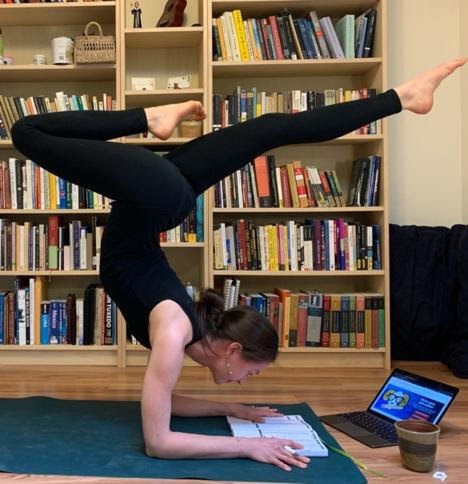Getting Back to It
By Anna
Every night before going to bed, I write down two things I’m grateful for that day in a small, smooth notebook gifted to me by my German “sister.” Growing up as an only child, I relished the year that my family hosted an exchange student from Bielefeld, Germany. Stefanie has always encouraged my writing practice by supplying me with numerous notebooks and pens over the years. This one was supposed to be for documenting trips and travels (we had always imagined taking one together), but, since traveling is far from my mind these days, it has served as the perfect gratitude journal. I am an on-again, off-again journal writer, but somehow this simple practice has stuck—well, except for last night when my partner and I rolled into bed after watching too many episodes of Tiger King. I find that exceptions to the rule don’t in and of themselves sabotage habits and routines, it’s “the getting back to” that’s important.
So, I will get back to this ritual tonight. Getting back to things after periods of abandonment can sometimes feel like a sheer act of will. It’s so much harder to get back to than to give up, let go, abandon, as the past few weeks in quarantine have taught me. Falling into sub-optimal (re: embarrassing) behaviors so quickly when normal routines are lacking. Regressing to primal instincts (hoarding supplies, food) when feeling threatened and fearful. Why? It’s as if impulsively checking the precise number of COVID-19 cases can give some semblance of control, counteracting all of the uncertainty.
Uncertainty. In Buddhism, uncertainty is a tenet of our very existence—the product of impermanence and change, ironically the only constants throughout our lives. But uncertainty is scary, and this global pandemic has brought that uncertainty to the body and has changed life all around the world. What would embracing this uncertainty look like? Perhaps, by letting go, even if just a little, of the habitual thoughts and beliefs that keep people thinking they “should” do this or that. “Stop shoulding yourself,” my friend Michelle has told me on several occasions.
For me, letting go has meant practicing yoga and running on any given day—something my old schedule would not have allowed for. It has meant lowering expectations for sticking to my Ph.D. exam reading schedule during these last few weeks of the semester. (I’m in my fourth year in the English PhD program, and I’m preparing to take my qualifying exams in the fall.) It has meant long bike rides through the meandering farmland nearby, virtual workouts with friends, and cleaning all the windows (even the skylights!) inside and outside my home. It has also meant embracing my boyfriend’s slower schedule, which finally allows us to cook meals together in the evenings (he used to get home at 9 or 10 every week night except Wednesdays).
Prioritizing self-care and relationships during this time has been so important for me. My parents live in town, and my mom and I have been meeting up in her neighborhood to go on “socially distant” walks together. This routine reminds me of last August, when I was diagnosed with cancer and walked with my mom every day for several weeks after surgery to get stronger. From my own experience, I’ve learned that uncertainty about one’s body, health, and safety can be one of the most existentially challenging frameworks in which to live.
But uncertainty can also lead to an appreciation of the present. And living in and attending to the present moment mindfully can be a powerful way to learn and grow in this world. In yoga, attending to the present moment during practice means having a steady gaze on a fixed point (drishti), an even breath while inhaling and exhaling (pranayam), and a stable pose (asana). The breath calms the nervous system, the gaze quiets the mind, and the pose strengthens and purifies the body. Without even one of these three tenants in place, the practice becomes nothing more than physical exercise.
Of all the habits that I have developed, abandoned, and returned to, yoga is the one that has remained the biggest constant in my life for almost a decade. What is it that has made this practice indispensable to my living, breathing, being in this world? Why have I not abandoned it in the same way I have let go of other half-formed habits over the years?
Yoga makes me curious. There is a never-ending capacity for learning and going deeper in the practice. There is no mastery, and the knowledge that comes from practice is embodied and experiential—it can never be learned through books alone.
These reasons are, perhaps, why my gratitude journal looks something like this:
3/31/20
–yoga practice
–maintaining ujjayi breath for the whole practice for the very first time—feeling so energized!
Yoga has made me a better writer by helping me cultivate my focus and attention. It has made me a more compassionate human to myself and others. And it has made me a lifelong learner. Not even a global pandemic will get between my mat and me.
This blog showcases the perspectives of UNC Chapel Hill community members learning and writing online. If you want to talk to a Writing and Learning Center coach about implementing strategies described in the blog, make an appointment with a writing coach or an academic coach today. Have an idea for a blog post about how you are learning and writing remotely? Contact us here.



